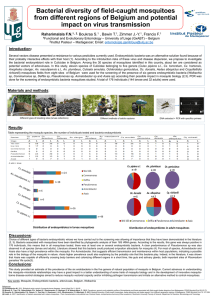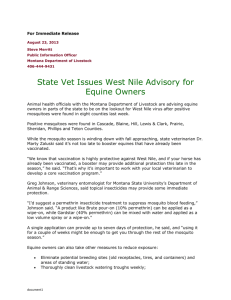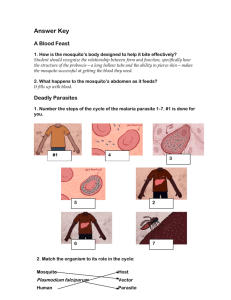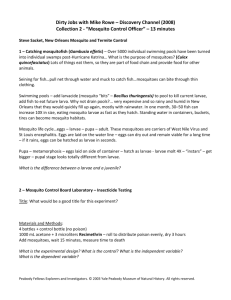1475-2875-13-206-S1
advertisement
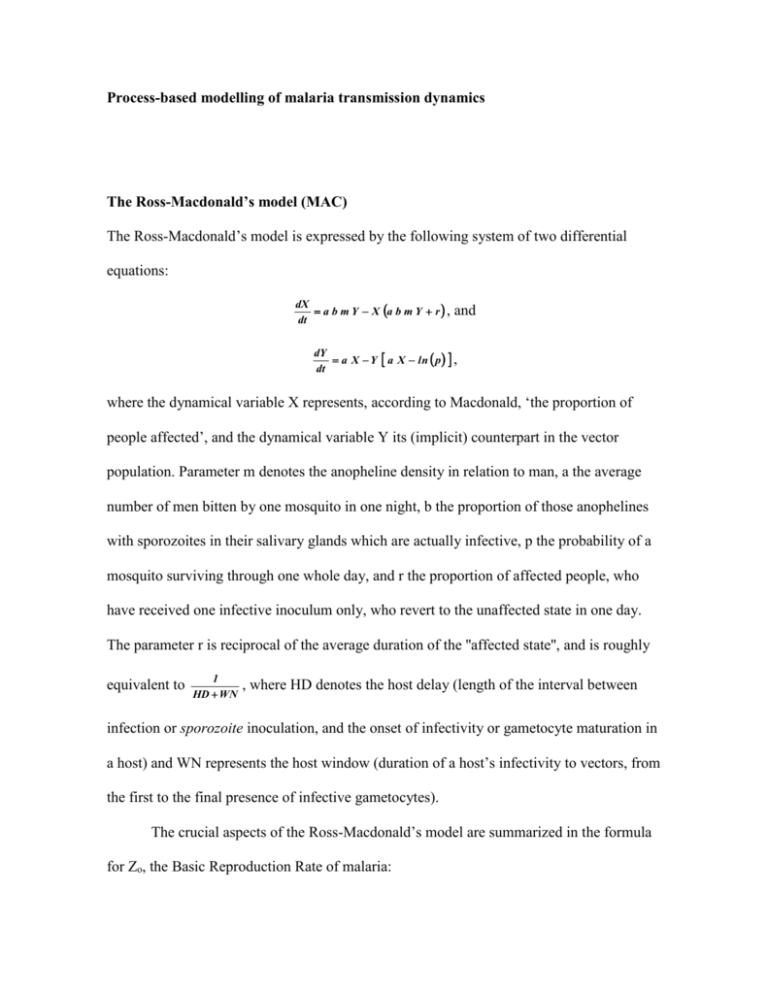
Process-based modelling of malaria transmission dynamics The Ross-Macdonald’s model (MAC) The Ross-Macdonald’s model is expressed by the following system of two differential equations: dX a b m Y X a b m Y r , dt and dY a X Y a X ln p , dt where the dynamical variable X represents, according to Macdonald, ‘the proportion of people affected’, and the dynamical variable Y its (implicit) counterpart in the vector population. Parameter m denotes the anopheline density in relation to man, a the average number of men bitten by one mosquito in one night, b the proportion of those anophelines with sporozoites in their salivary glands which are actually infective, p the probability of a mosquito surviving through one whole day, and r the proportion of affected people, who have received one infective inoculum only, who revert to the unaffected state in one day. The parameter r is reciprocal of the average duration of the ''affected state'', and is roughly equivalent to 1 HD WN , where HD denotes the host delay (length of the interval between infection or sporozoite inoculation, and the onset of infectivity or gametocyte maturation in a host) and WN represents the host window (duration of a host’s infectivity to vectors, from the first to the final presence of infective gametocytes). The crucial aspects of the Ross-Macdonald’s model are summarized in the formula for Zo, the Basic Reproduction Rate of malaria: Z0 m a 2 b pn b C, r ln p r where the parameter n represents ‘the time taken for completion of the extrinsic cycle’, and: C m a 2 pn ln p , summarizes the ‘Vectorial Capacity’ of malaria. Macdonald derived Zo as an estimate of the average number of secondary cases arising in a very large population at risk of completely susceptible humans following the introduction of a single primary case. Zo=1 was defined as the transmission threshold: for values above, malaria cases will propagate; for values below, the disease will recede. The formula for Zo holds that the influence of vector survivorship (p) is greater than the influence of the average number of men bitten by one mosquito in one day (a) or the sporogonic cycle (n), which are in turn greater than the influence of the proportion b, the density m, or the proportion r. Hence, Macdonald considered the vector survivorship as the single most important element in the Basic Reproduction Rate of malaria. Macdonald’s affected proportions do not distinguish between infected and infectious stages. His conclusion with respect to host infectivity was: ‘transmission can be altered by reduction of the mean period of infectivity of a case of malaria. The influence is, however, relatively low; the reproduction rate varies directly with the mean duration of infectivity, very great changes in which would be necessary to reduce the high rates common in Africa and some other places below the critical level’. Macdonald’s b is a measure of incidence (e.g. by its role in expressions for ‘inoculation rate’ and ‘force of infection’), and r the reciprocal of the average duration of the ‘affected’ state. Macdonald wrote that ‘in nature, the value of the reproduction rate is greatly influenced by immunity altering the values of r and b’. The stock-flow model of the Ross-Macdonald’s model is shown in Figure 1. The Anderson and May’s model (AM) Anderson and May extended the Ross-Macdonald’s model by considering the proportions of exposed individuals (Eh) and exposed mosquitoes (Em), and by including the latency of infection in human hosts (th) and mosquito vectors (tm). The AM model is thus based on the following system of four coupled ordinary differential equations (note time lags in the equations): dEh a b m Im t 1 Eh t Ih t a b m Im t t h 1 Eh t t h Ih t t h e r 1 t h r Ih t 1 Eh t , dt dIh a b m Im t t h 1 Eh t t h Ih t t h e r 1 t h r Ih t 1 Ih t , dt dEm a c Ih t 1 Em t Im t a c Ih t tm 1 Em t t m Im t t m e 2 t m 2 Em t , dt and dIm a c Ih t tm 1 Em t tm Im t tm e 1 t m 2 Im t . dt Variable a denotes the mosquito biting rate. Variable m, or mosquito density, is calculated through the linear regression m 3 R d , where 3 represents the rainfall to mosquito constant, R the total monthly rainfall, and d the total human population at risk. Lastly, parameters 1 and 2 represent, respectively, the mortality rates of humans and mosquitoes. 2 is given by 2 log p , mosquito vector, is expressed as 1 / U where p, the daily survival probability of the , and U denotes the total gonotrophic cycle length. The mathematical model proposed by Worrall, Connor and Thomson (WCT) This temperature- and rainfall-driven dynamic model of malaria transmission was proposed to predict epidemics in areas where brief seasonal transmission and occasional epidemics do not enable acquired immunity, and to examine the relationship between the intervention timing and transmission intensity on the effectiveness of indoor residual spraying (IRS). WCT is composed of six sub-models that allow estimating: (SM1) the number of adult female mosquitoes as a function of rainfall, (SM2) the length of the gonotrophic or feeding cycle as a function of temperature, (SM3) the duration of the sporogonic cycle as a function of temperature, (SM4) the vector survivorship in terms of survival probability per gonotrophic cycle and per day, (SM5) the sporozoite rate, and (SM6) the number of new infections, super-infections and recoveries. The combination of SM3 and SM4 allows calculating ‘the probability of the vector surviving long enough for sporogonic development to be completed’. SM4 is also used ‘to simulate the effects of a residual spray program, which is considered in terms of its impact upon the probability of vector survival per gonotrophic cycle’. In SM1, the number of mosquitoes emerging each month (q) is estimated through the linear regression q R, where represents the linear scaling factor (or rainfall to mosquito constant) and R the monthly rainfall total. In SM2, the total gonotrophic cycle length (U) is estimated as: fu , U T l g u where fu T l gu (or u) represents the period of time required by a female Anopheles to digest the blood meal (maturation of the ovaries), and denotes the length of the period required by the adult mosquito to search for a suitable water body, lay the cohort of eggs, find a new host and bite again. fu represents the total number of degree-days needed to complete development, gu the threshold temperature below which development ceases, and (T+l) the indoor temperatures, which are function of the outdoor ambient temperatures (T) and an adjustment factor (l). In SM3, the length of the sporogonic cycle is expressed as: N fN ( T N gN ) , where fN represents the number of degree-days needed to complete development, and gN denotes the temperature threshold below which development ceases. Temperature TN is ‘adjusted to account for differences between indoor and outdoor resting temperatures, using a weighting system, based on the period of time the vector spends indoors as a proportion of gonotrophic cycle length’, TN T lu U . SM4 defines two populations of mosquitoes: covered (C) and not covered (1-C) by the spray program, where C represents the percentage coverage achieved by the spraying campaign. The daily survival probability of the mosquito vector is expressed as 1 / U , where denotes the probability of the vector surviving each gonotrophic cycle (assumed to be constant) in the population not covered by the campaign. is reduced by in the population covered by the spray program immediately after spraying, gradually increasing back towards at a rate of /6 per month over the effective residual life of the insecticide (assumed to be 6 months). Thus, the mean probability of the daily survival (P) for the whole mosquito population is given by: ( 1 C ) C 1U . In SM5, the sporozoite rate (S) is estimated using the equation: S xhkvP N , 1 xhkv where x denotes the proportion of humans that are infectious, h the proportion of human blood fed mosquitoes, k the probability of the vector becoming infected per infectious meal, and v the probability of the vector becoming infectious with the malaria parasite. The formula uses the probability of surviving the gonotrophic cycle for an unsprayed population (); in a sprayed situation this parameter is substituted for ( 1 C ) C . Lastly, in SM6 the frequency at which mosquitoes feed on humans (a) is estimated as h/U, and the number of infectious mosquitoes biting humans is calculated as the product of the sporozoite rate (S), the number of mosquitoes (q), and the person biting habit (a). The probability of a human receiving an infectious bite (R) is given by 1 1 1 d Sqa , where d denotes the total human population at risk. The number of people recovering at time t (ct) is given by c I Z r , where I represents the number of infected humans, r the probability of recovery of new infected humans after time t, and Z the number of super-infections (or Z= R I). Thus, the number of infected humans at time t (It) is given by: I t I t 1 ct Ft , where Ft denotes the number of people newly infected at time t or R(d-I). The total number of reported infected humans at time t is given by: *It, where denotes the proportion of positive cases in the community reported to health facilities. The schematic diagram of the WCT model and the stock-flow diagrams of its SM3 (estimation of the length of the sporogonic cycle) and SM6 (dynamics of new infections, super-infections and recoveries) sub-models are depicted in Figure 2. The coupled mosquito-human model of malaria proposed by Alonso, Bouma and Pascual (ABP) The ABP coupled mosquito-human model was implemented to assess the impacts of increasing trends in local ambient temperatures on malaria transmission dynamics in a highland region of East Africa. The model was run with and without temperature trends over a three-decade simulation period in order to address how much of a change in the size of epidemics could be attributed to the observed warmer temperatures. The model couples the dynamics of the disease in two main components: the human population and the mosquito vector. The former consists of a classical system of ordinary differential equations in which five different classes are considered: susceptible non-infected human hosts (S), infected but non-infectious individuals (E), infected individuals who acquire asymptomatic infection but are nevertheless infectious and can transmit malaria parasites to mosquito vectors (I), recovered individuals/acquired immunity or those human hosts who have cleared parasitaemia, or have too low a level of parasitaemia to effectively infect the vector (R), and infected individuals who present symptoms and therefore receive some sort of clinical treatment (C). The system of ordinary differential equations for this component is given by: dS B S R H S C dt , dE S H E E dt , dI 1 E I C r I I H I dt dR r I R H R dt , , and dC E I C C C H C . dt In the formulation of the full version of the ABP model, the authors do not include the parameters and in the dynamics of the total number of infected individuals who acquire asymptomatic infection (I) and the total number of infected individuals who present symptoms and therefore receive clinical treatment (C), respectively. Thus, the right-hand side of their equations only includes five terms. Exogenous variables B and H in the system of equations for the human host component represent, respectively, the replenishment of susceptible individuals through immigration or birth, and the individual losses due to mortality or more generally, population turnover. In the model, variables B and H balance each other so that the total human population at risk (N=S+E+I+R+C) remains constant. Thus, B=HN. The transmission rate, , or “force of infection”, or the per-capita probability that susceptible individuals acquire the infection per unit time as a result of infecting bites from mosquitoes, is given by: b M t t a e , N where b is the probability that an infectious bite results in infection, M(t) the total population of mosquitoes, (t) the fraction of infectious mosquitoes at time t, and a the number of bites per individual mosquito per unit time. The first term in represents the local transmission where the fraction of infectious mosquitoes at time t is a consequence of acquiring the parasite from infectious humans at some earlier time. The second, additive term e is an external force of infection and represents, for example, those individuals who acquire malaria infection when visiting endemic areas. The variable represents the rate of loss of immunity and is a function of the intensity of mosquito exposure (as the frequency of mosquito bites increases, the rate of loss of immunity tends to decrease) as follows: exp 0 1 , where denotes the rate of infectious bites per human, which is given by aW N , and 0 the loss of immunity basal rate, i.e. when tends to zero. The variable W represents the total number of infectious mosquitoes. The variable represents the CS clearance or recovery rate. The variable r represents the IR clearance or recovery rate and is a function of the intensity of mosquito exposure (as the frequency of mosquito bites increases, the recovery rate tends to decrease) as follows: r exp r0 1 , where r0 denotes the IR recovery basal rate, i.e. when tends to zero. 1 denotes the average time in the exposed phase. represents the fraction of infections in humans that fully develops severe malaria symptoms and, then, receive clinical treatment (C). denotes a factor that decreases the per-capita transmission rate () when asymptomatic but infectious individuals (I) can present a relapse of severe malaria symptoms if they are bitten again. Lastly, variable represents the CI recovery rate. Figure 3 depicts the stock-flow model of the human host component of the ABP coupled mosquito-human model. The mosquito population model considers, in turn, the number of larvae (L) and adult mosquitoes (M); see Figure 4. The dynamics of the level variable L is given by: dL K L f M L L dL L , dt K where f is the per-capita fecundity rate or the maximum number of eggs that enter the larval stage per female per unit time. Since female mosquitoes lay eggs only once between blood meals, the fecundity and biting rates can be related following f = F a, where F denotes the mosquito fecundity factor. The number of eggs per adult female and unit time can be written as: Nf n a , where n is the number of eggs per oviposition event. The per-capita fecundity rate, f, should be lower than Nf to account for some mortality at the egg stage. The variable K denotes the larvae carrying capacity and is determined by rainfall, since water pools of different size provide the habitat for mosquito breeding and larvae development. Also, larvae survival decreases when precipitation is large, above a given threshold that depends on how much rain has fallen in previous months. The carrying capacity is modelled in ABP following: dK k A P kE K , dt where kA and kE represent, respectively, the carrying capacity conversion factor and loss rate. Variable L denotes the larval mortality rate and is approximated as follows: L 0 L T L P , where 0 is a basic mortality rate caused by temperature- or rain-independent processes, such as predation. The temperature-dependent larval mortality rate, L(T), is given by: 1.1946 0.0804 T 14 1 / 2 L 16 L 14 T 14 L T L 1 / 3 L 16 L 18 L 20 0 . 062157 0.0052243 T T 14 14 T 16 16 T 20 20 T 34 , where L(14), L(16), L(18), and L(20) denote the per-capita larvae death rate (inverse of the larval average life time) at temperatures of 14, 16, 18, and 20°C. L(P) is a function that depends on daily rainfall and measures how much mortality rate increases as a consequence of heavy rain. Specifically, L(P) is given by: L P R P P 12 , where R is a proportional factor transforming a positive deviation from the moving average, due to a peak in rainfall, into an increase in larval mortality. This parameter, socalled death factor, is introduced to represent the washout effect for the larvae. x is x if x > 0 and 0 otherwise. Lastly, P 12 is a 12-month moving average calculated from the rainfall time series. Variable dL represents the larval development rate and is related to the ambient temperature following a simple regression used for Anopheles gambiae: d L 0.00554 T 0.06737 , where T represents the temperature expressed in degrees Celsius. The adult mosquito population is divided into three classes: susceptible non-infected mosquitoes (X), infected non-infectious mosquitoes, or becoming exposed when they bite an infectious human (V) and infectious mosquitoes (W). The system of ordinary differential equations is given by: dX c a y X M X dL L , dt dV c a y X P V M V dt dW P V M W dt , and . Variable c denotes the human host to mosquito probability of transmission. Variables y and M represent, respectively, the fraction of human population transmitting the parasite to the mosquito vector, and the adult mosquito mortality. The average lifetime of mosquitoes depends on temperature as follows: 4.4 1.31 T 0.03 T 2 . Therefore, the per-capita death rate of adult mosquitoes can be written as: M 1 . P is the per-capita rate at which new infectious mosquitoes arise, a quantity related to the duration of sporogony. This development time is also influenced by temperature as follows: P 0.009 T 0.1441 , specifically for Plasmodium falciparum incubation within female mosquitoes. The ABP model uses a simple regression between the inverse of the average gonotrophic cycle ( 1 ta ), or roughly the biting rate (expressed in number of bites per mosquito per day), and the ambient temperature, as follows: a~ 1 0.091678 T 1.7982 . ta In the ABP full model version the human E class and the mosquito V class for the exposed individuals (not yet infectious) are divided into nH and nV latent classes (not shown here), respectively. The means of these incubation times are given by 1/H and 1/V, respectively, whereas their variances decrease as function of the number of latent classes. The outdoor ambient temperature drives the larval parameters L and dL. The ABP model also considers an effective temperature, Te, which is higher than the outdoor ambient temperature, in the functions for adult mosquito mortality (M), biting rate (a), and the duration of sporogony (P). Te is given by: Te To 1 x T , where x is the temperature weighting parameter, and T is the maximum allowed difference between the maximum higher temperature adult mosquitoes can experience, Ti, and the temperature outdoors, To. MME RESULTS MacDonald (1957) RESULTS 2 r_MD Feeding frequency Vectorial capacity m_C a a Tmin_bd RISK X2 a n_SIM a b p_SIM p_SIM Y2 HBI m_C LIT_1 INI_F X X Y C VB T_C_S Dbd a b X1 NH b NV Y1 a NV m_C m_C Cal_MAC Basic reproduction rate a Vector survivorship REL p_SIM b Sporogonic cycle DV WN T_C_S Dm LIT_3 p X : Proportion of people affected. Y : Proportion of vectors affected. Main endogenous variables HD T_C_S p_SIM Level variables n Zo NR_M r_MD k n_SIM n_SIM r_MD 1 / (DH+WN) Tmin_p LIT_2 Figure 1 Ross-Macdonald’s stock-flow model C : Vectorial capacity. r_MD : Proportion of affected people, w ho have received one infective inoculum only, w ho revert to the unaffected state in one day. Zo : Basic Reproduction Rate. Mu (1) R T I (2) fu gu Mosquitoes emerging each month Tu u fN Length of the sporogonic cycle Nu Total gonotrophic cycle length TN r gN INFECTED (3) Probability of daily surviving Probability of an infectious bite (5) k v C h (4) d Sporozoite rate (6) x DYNAMIC MODEL SUB-MODEL 3 SPOROGONIC CYCLE LENGTH INC_W Landa d_W LIT_2 n I_W INI_F Dm TUL N_W Tmin_p u_W TN T_C_S c_r F_W l_T r_i I_C d_W DV R_h Z Figure 2 Schematic diagram (top) and stock-flow diagrams of the SM3 and the SM6 sub-models (bottom) of the WCT mathematical tool Human population Alpha Sym ptom atic/ clinical tre atm e nt De lta_h Rh14 Rh4 Rh15 Nu R ho Rh9 Susce ptible non-infe cte d C De lta_h De lta_h Eta B N Sigm a Eh Infe cte d but non-infe ctious N rh Rh6 Gam m a Rh10 Rh7 Eh Xi Rh2 Acquire d im m unity I Rh11 Rh12 R Eh I C Be ta S Rh1 De lta_h Rh8 Rh5 Rh3 S Gam m a Be ta Psi Asym ptom atic infe ction De lta_h Rh13 R De lta_h Figure 3 Stock-flow model of the human host component of the Alonso, Bouma and Pascual coupled mosquito-human malaria model Figure 4 Stock-flow model of the mosquito population component of the Alonso, Bouma and Pascual coupled mosquito-human malaria model

